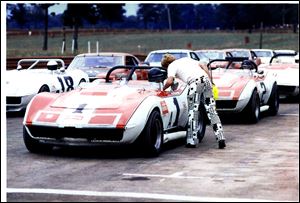
Historic Corvette linked to Owens Corning being auctioned
1/18/2013
This 1968 Chevrolet Corvette race car racked up a bevy of wins over the years, including two class victories at the 24 Hours of Daytona. The restored vehicle will be auctioned on Saturday.
A restored 1968 Chevrolet Corvette race car that was sponsored by Owens Corning is going up for auction in Arizona this weekend, and it could bring bids nearing $1 million.
The story of the car, which racked up an impressive win list including two class victories at the 24 Hours of Daytona, dates to when Toledo’s Owens Corning (then known as Owens Corning Fiberglas) looked for a way to grow its presence as an automotive-parts supplier and to strengthen its relationship with General Motors.
At that time, GM wasn’t sponsoring race cars, said Bill Hamilton, a former public relations executive with Owens Corning. So Owens Corning did, partnering with a couple of young drivers to form the Owens Corning Fiberglas racing team.
The team raced two specially prepared L88 Corvettes — the fastest, most powerful Corvettes of the era. And they won. The team pulled off an impressive string of 22 consecutive Sports Car Club of America events. Barrett-Jackson of Scottsdale, Ariz., the company running the auction, said the car being offered won 12 of those races.
Mr. Hamilton said Owens Corning took advantage of the success, assigning a public relations executive to the team, and taking customers to events such as the 24 Hours of Daytona.
“I am confident the company’s involvement with the racing team helped move the market along toward using more composite materials of all types,” he said. “The team was a first-class operation that won races and respect that reflected well on Owens Corning.”
Though Owens Corning’s relationship with the racing team was purely a sponsorship, the company played a larger role in Corvette history. “Owens Corning didn’t have anything to do with the development of the racing cars, but had a lot to do with the development of the early Corvette, which was launched with the 1953 model,” Mr. Hamilton said.
Chevrolet built the first Corvette as a show car for the 1953 GM Motorama in New York. It was a sensation. Based on public response, GM decided to build the car as a production vehicle.
The automaker chose Molded Fiber Glass Companies of Ashtabula, Ohio, to build the fiber-glass body. But MFG needed some help, so company founder Robert Morrison reached out to Harold Boeschenstein, a friend who headed Owens Corning at the time.
The Toledo company eventually would lend money and provide engineering and technical assistance to MFG.
“It was an important and significant relationship,” said Richard Morrison, MFG’s president and chief executive officer, and Robert Morrison's son.
Chevy made 300 Corvettes in 1953, all painted polo white. While the car was groundbreaking for a number of reasons, it was especially important for companies such as Owens Corning and MFG because of its fiber-glass body.
“This was of course a big deal because it was really the watershed event for composites in the world,” Mr. Morrison said. “To have Chevrolet decide they’re going to build their new sports car out of composites was quite a step forward.”
Sixty years later, the Corvette remains among America’s most mesmerizing cars. And GM still builds them with parts made in Ashtabula by MFG.
“We’re very involved with Corvette and we’re very honored to be involved with the next generation of Corvette,” Mr. Morrison said.
The completely redesigned seventh-generation 2014 Corvette was perhaps the biggest star of the North American International Auto Show preview this week. The first production model of that vehicle will be sold in Scottsdale, GM announced on Wednesday. It’s due on the block immediately after the Owens Corning Corvette.
OC’s racing endeavor ended in February, 1971. After the car’s restoration in the early 2000s, it was displayed for a time at the National Corvette Museum in Bowling Green, Ky. It last went up for auction in August, where bids reached $730,000. It didn’t sell — the bid didn’t meet the reserve price.
Contact Tyrel Linkhorn at: tlinkhorn@theblade.com or 419-724-6134.